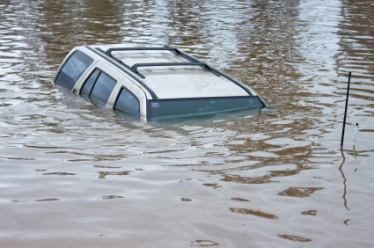Flooded cars may seem like bargains, but serious damage can surface later
Emmet Pierce
If your car is totaled by your insurance company because of serious flood damage, it might not go straight to the junkyard. There’s a chance it will be sent out of state and resold to an unsuspecting consumer.
Following natural disasters like Superstorm Sandy, flood-damaged cars sometimes are dried out and then marketed without the vehicles’ dirty secrets being told. In fact, the number of cars flooded and destroyed by Sandy may far surpass the number of vehicles – 640,000 – destroyed by Hurricane Katrina. If this prediction holds true, Sandy “would be the single-largest disaster to ever impact the country’s vehicles,” according to Carfax, a company that checks vehicle histories.
“When it comes to flooded cars, buyer beware,” says Pete Moraga, a spokesman for the nonprofit Insurance Information Network of California. “Because cars are so electronic and computerized, there can be damage that isn’t visible. There could be longstanding problems that can affect safety devices. Are those air bags actually going to work? Chances are that they won’t.”

The hurricanes of 2005 – most notably Katrina and Rita – caused flood damage to more than 325,000 cars in the U.S., according to the National Insurance Crime Bureau.
No one knows how many cars that were flooded during Sandy will find their way back onto the highway. Carfax, a company that checks vehicle histories, estimates about half of all flood-damaged vehicles return to the road, spokesman Christopher Basso says. Most of these cars are properly processed by insurers or have titles that indicate there’s been flood damage, he says, but some slip through the system to be resold without proper documentation.
Is your car covered for flood damage?
What decides whether a car should be written off as a total loss varies by insurance company and may be regulated by states. Typically, cars are totaled when they can’t be restored so they can be driven safely or when repairs cost more than the vehicles are worth. Flooded cars often are totaled because the water has seriously damaged expensive electronic components.
If you have comprehensive car insurance coverage – pays for non-collision losses such as fire, theft and storms – you should be covered if flooding damages your car. When your car is totaled, your insurer will pay you the car’s actual cash value, minus your deductible, and the car then may be sold as a salvaged vehicle.
Totaled flood vehicles may be auctioned to wholesalers or salvage operators, says Frank Scafidi, a spokesman for the National Insurance Crime Bureau. Titles for these vehicles should show they were damaged, but sometimes cars may be taken to other states and retitled to hide the flood damage, he says.
“Before they are put on the market, they may have had their title ‘washed’ two or three times,” Scafidi says. He warns that these retitled cars could show up anywhere in the U.S., not just in the areas that sustained flood damage.
Protect yourself when buying a used car
In the months ahead, if you see a used car that looks great but is being sold well below market value, be on your guard, Scafidi says.
“If somebody is shopping for a used 2010 Tahoe and the value is around $25,000, and all of a sudden they see one for $15,000, that is a clue,” he says.
One way to check out a car’s past is to obtain a vehicle history report. Carfax sells these reports but is offering free flood checkup in Sandy’s wake, Basso says. The National Insurance Crime Bureau’s free VINCheck database also lets you investigate a car’s background.
Dan Young, a spokesman for the Carstar chain of collision repair shops, offers these six tips to avoid buying a flood-damaged car:
- Try the sniff test. Get in the car and roll up the windows to check for the scent of mold and mildew.
- Feel around the interior around for wet spots on the seat and carpeting. If you can lift the carpet, look for watermarks.
- Look for mismatched upholstery.
- Look underneath the car for any signs of holes that were drilled to drain water.
- Turn the car on and off and test electrical items, such as door locks, power seats, blinkers and brake lights.
- When in doubt, take the car to a trusted mechanic.
If someone properly discloses to you that a car was salvaged from a flooded area, you shouldn’t reject it, Scafidi says.
“If the buyer is savvy, they can pick up a pretty good vehicle for little money,” he says. “There is nothing wrong, as long as people are aware upfront what they are dealing with.”
